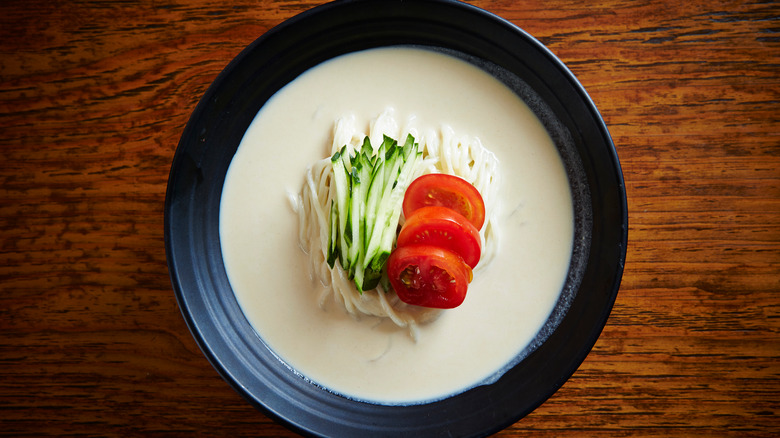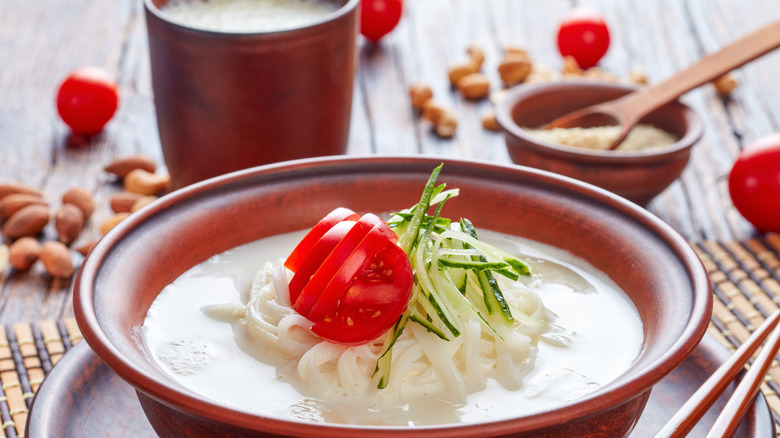The Cold Korean Soy Milk Noodle Soup That's Perfect For Hot Summer Days
As the days get hotter, your craving for noodles doesn't have to equate to sizzling, steamy noodle soups like ramen or pho — although there's nothing wrong with enjoying either in the summertime. Enter kongguksu (or kong guksu), a classic and beloved Korean dish. With its creamy and soothing broth, this cold soy milk noodle soup is ideal for balmy days.
The name kongguksu translates to "soybean noodles" in Korean, and unsurprisingly, this dish has long been a warm-weather refresher in Korea. The ingredients are straightforward yet adaptable, usually comprised of a bed of thin wheat noodles nestled in a rich, chilled, flavorful soy milk broth.
This balance of creamy and cool, combined with Q-textured noodles, soothes and refreshes. And whether you stick to the basics or choose to adorn it with more ingredients, kongguksu is poised to be your favorite summer staple, as it has been for centuries in Korea.
Kongguksu has been a summertime dish for centuries in Korea
Kongguksu's history is as rich as its flavors. The first recorded mention of kongguksu was in a Joseon cookbook, published in the 19th century. Reflecting on why its popularity spread and took off, it's most likely that kongguksu's origins are deeply intertwined with Buddhism and traditional Korean temple cuisine, emphasizing vegan and vegetarian diets without any artificial or processed flavors. The simplicity of the dish, focusing on fresh, seasonal ingredients, embodies the Buddhist principles of balance, nature, and harmony.
And despite its reputation as an ideal summer refreshment, this endearing dish transcends seasons. Today, in bustling Seoul and the tranquil countryside of South Korea, kongguksu remains a comforting and nostalgic presence, often a childhood favorite amongst those who live there. To bring some Korean summer magic into your home, let's delve into the ingredients of kongguksu.
How to prepare and serve kongguksu
At its core, the creation of kongguksu relies on just a handful of ingredients: dried soybeans, water, wheat noodles, and seasoning like salt. Some also enjoy kongguksu sweetened with sugar or topped with slivers of cucumber and slices of tomato for an extra hydrating kick.
To make kongguksu at home, the process traditionally starts with making homemade soy milk. First, soak the dried soybeans, usually overnight, then cook them in water until tender. The soybeans are then blended or puréed with water and salt until smooth. You can also add some pine nuts and sesame seeds for a touch of earthiness. This mixture is then strained, and the resulting liquid forms the creamy, rich broth that is then chilled.
With kongguksu, thin wheat noodles, like somyeon or somen, prized for their chewy texture, are ideal. These noodles are cooked to al dente or Q perfection, placed in a bowl, and then blanketed with cold soy milk broth. Ice cubes can be added to the broth for an extra chilly touch, making it even more refreshing in hot weather.
For the time-poor, modern recipe adaptations offer convenient shortcuts. Using store-bought soy milk, for instance, cuts down the preparation time without compromising the taste too much. Of course, there's an unparalleled charm in crafting kongguksu the traditional way to appreciate the dish's rich history and flavors fully.


